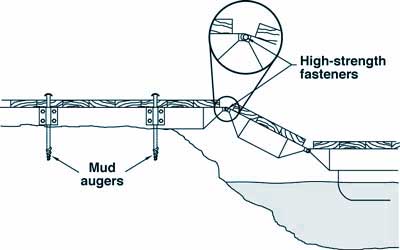Shore Anchorage and Access
The means of getting from the shore to the floating structure depends on the site. The shoreline access structure often provides additional anchorage or may provide all of the anchorage. When the shoreline access also provides shoreline anchorage, the connection must be strong enough for both purposes.
Shoreline AccessWhen shoreline anchorage is provided by some means other than the access structure, access is quite simple. Gangways or ramps are the traditional means of access. They allow for moderate water level changes without adjustment. One end of the ramp is on the shoreline and the other is on the bridge or dock. Additional floats may be needed where the ramp joins the floating structure, either on the structure itself or on the ramp if it contacts the water. Sometimes the ramp will need to be connected, usually with hinges, to a landing platform on the shoreline. Ramps may also be hinged to the bridge or dock. Hinging the ramp to the shoreline and structure will provide additional anchorage. Ramps can be mounted on rollers on the end of the structure. This creates a step that may prevent the structure from meeting accessibility standards for persons who are physically challenged. Provide traction on the ramp by placing cleats at 1– to 2–foot intervals (accessibility issues are a concern) or by using metal perforated floors, plastic traction mats, a traction coating, or some other method. In general, the ramp should be as wide as the structure, both for user comfort and to help relieve stress on the hinges, when applicable.
In areas with fluctuating water levels, ramps should be installed so that the ramp is level with the dock during high water.
The ramp angle should never exceed 30 degrees (67– percent slope). An angle of 20 degrees (44–percent slope) is too extreme for some users. The maximum slope of a ramp should be 1:12 or less (8.33 percent) to meet accessibility guidelines. Consult with accessibility interest groups if your structure will be located in an accessible setting. Several ways to decrease the ramp's angle include lowering the mounting point at the shoreline, raising the mounting point on the bridge, and increasing the length of the ramp.
Shoreline AnchorageOften the shoreline anchorage provides most if not all the anchorage for the floating structure. The forces on the anchorage can be very large. The dock acts as a lever. The force of an impact at the end of a dock can be multiplied many times when it acts on the shoreline anchorage.
The simplest means of shoreline anchorage is hinging, pinning, or tying the structure to a crib, retaining wall, bedrock, or another solid structure. Mounting boards and landing platforms are also very common. A mounting board is made from pieces of 2–inch–thick dimensional lumber that are the same width and height as the adjacent ramp. A landing platform is a longer structure that is the same width as the ramp and is constructed with the same materials. Mounting boards and landing platforms are anchored to solid earth through concrete foundations, helical screws, spuds, or pipes pounded into soft earth. Mounting boards are connected with brackets, pipes pegged or glued into holes drilled in rock, expandable rock bolts, or similar methods (figure 28).

Figure 28—Mud augers used to secure a shoreline access structure.
High–strength connection brackets provide additional anchorage.
At certain times the shoreline will not have enough adequate anchorage points or a means of accessing a floating structure. Shallow areas may require dredging or extending the shoreline with fill until the water is deep enough for the floating structure. Other means include using a structure such as a boardwalk or cantilever dock (figure 29) to reach the floating structure. Soft shorelines may require posts or piles fixed into the earth to provide an adequate anchorage point. Cribs are highly versatile structures that can provide excellent anchorage as well as stable access.

Figure 29—The drawing of the dock system on the cover shows how
a boardwalk is used to cross a wetland to open water. Other methods
could also have been used, depending on the site's conditions.
For al long description of this image click here.

